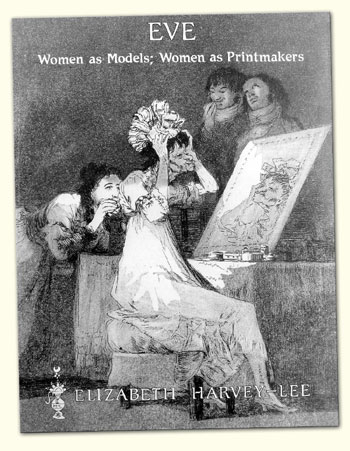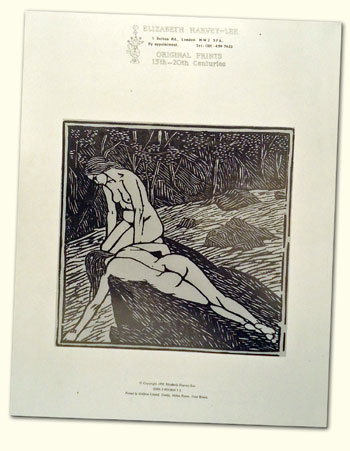|
EVE
 Women
as Models; Women as Printmakers Women
as Models; Women as Printmakers
While
women printmakers are scarcely recorded till the 17th
century, images of women date from the very earliest
days of printmaking. From c1390 they are portrayed
in incidents from the life of the Virgin and as images
of holy saints, produced as woodcuts for convents and
centres of pilgrimage. In secular imagery they appear
on playing cards and tarot cards. In intaglio prints
they appear in similar contexts from c1440.
Already
from the later 15th century occasional examples are
found of genre scenes with knights attending ladies,
rustic courting and merriment in taverns, and even
studies of women’s heads, though not defined
portraits. Many of the genre scenes were intended to
be symbolic of the transience of life.
By
the 16th century women were being portrayed in many
roles. The development of book illustration extended
the diversity of range. Though the majority of prints
still represented biblical passages from the old and
new testaments, the Renaissance introduced new or parallel
themes from the classical mythology of ancient Greece
or Rome; or from contemporary authors such as Dante
or Boccaccio; or drawn from the more homely advice
proffered in emblem books. In this way, particularly
in northern Europe, where artists tended to transpose
biblical scenes to a contemporary setting, every aspect
of life and relationships between the sexes came to
be interpreted in print. The Renaissance awareness of
the temporal, the individual and history led to the
development of the portrait, both male and female.
Renaissance,
Mannerist and Baroque prints of women can thus be enjoyed
on several levels. Iconography offers an enormous scope
of intellectual concepts, which yet can be couched
in the manners, dress and customs of everyday life.
Accepted timeless truths are presented in the reality
of the artist’s own time. The artist’s
family is a mirror of the Holy Family. Examples such
as 'Samson & Delilah' and 'Judith & Holofernes',
demonstrate the power women can gain over men. Certain
aspects of moral worth and religion, abstract ideas
of truth, justice and beauty, counterbalanced by evil,
deceit and envy, are demonstrated through the female
form. Giving gender to inanimate objects and persona
to abstract concepts, according to characteristics
recognised by mankind as essentially male or female
is inherent in human thought. Most Latin and Germanic
languages still designate nouns as masculine or feminine.
However had society been dominated by women in classical
times would Beauty be personified as a man rather than
a woman?
By
the close of the 18th century artists were beginning
to approach the imaging of women differently, demonstrated
in the work of Goya, last of the Old Masters and first
of the Moderns. Goya anticipated the satire of Daumier
and the impressionism of Manet.
In
the modern period artists have tended to delight in
the individual model herself and the technical and
stylistic means of achieving their desired expression.
No longer an ostensibly elevated intention of purpose
was felt necessary for the excuse of depicting the
female form; Venus abdicated while Leda vanished. Eve
was no longer reprehensible for the fall of man. The
Impressionists were artist-reporters, their eyes objective
even when affectionate. Paris was the centre of the
art world and the Parisienne, whether gamin,
trottin, grande dame or simply
femme, whether
wife, mother, companion, sister, mistress or other
role, epitomised the art of the period, to such an
extent that in her honour the end of the 19th century
is called La Belle Epoque.
However
the modern period has its dichotomies. The dialogue
between the naturalistic 'real' and the 'ideal' had
followers on both sides. The pre-Raphaelites and their
followers in England and later the Symbolists in France
and Germany demanded more of the medium than art for
art’s
sake or a small piece of reality encapsulated. They
sought a distillation of eternal truth, which was also
most frequently expressed through an image of womankind.
 In
Modern British printmaking of the early decades of
the 20th century some artists specialised in images
of women, most specifically Brockhurst and Russell
Flint; for others the subject was incidental though
responsible for the occasional memorable female image. In
Modern British printmaking of the early decades of
the 20th century some artists specialised in images
of women, most specifically Brockhurst and Russell
Flint; for others the subject was incidental though
responsible for the occasional memorable female image.
Until
the most recent times, it has long been acknowledged
that women excel at the literary and musical arts
but do not in general attain the same achievement in
the plastic arts. Did these require a single-mindedness
to which most women in the past have been unable to
commit themselves and instead the relationships and
demands of family life have taken priority? Käthe
Kollwitz recognized in herself a bi-sexuality and put
her artistic self down entirely to the masculine in
her make-up. It is noticeable that it is only in the
20th century, when women are socially and economically
free as never before to lead independent lives, that
women artists have proliferated.
Though
nuns may have contributed to the incunabula of printmaking,
historically women do not get recognized as printmakers
until the 17th century, and then names are still very
few. The likes of Geertruyd Roghman, Magdalena van
de Passe and Claudine Stella all tended to be from
families of engravers and pupils of their fathers,
uncles or brothers. Their work however holds it own.
Most were from Holland or France, though Elisabetta
Sirani was an Italian exception. Occasionally widows,
though not practising printmakers, took over their
husband’s print publishing activities. In the
18th century one is aware only of Angelica Kauffman,
working in England; but the century as a whole was
dominated by reproductive engraving rather than original
printmaking by either sex.
Women
play an increasingly larger role as printmakers from
the later decades of the 19th century onwards, when
independent art education became available to them.
Women such as Berthe Morisot, Mary Cassatt, Käthe
Kollwitz, Paula Modersohn-Becker, Sonia Delaunay, Marie
Larencin and Laura Knight have international reputations
as artists, in the unisex context of art history.
It
is interesting to note that in modern British wood
engraving women made a significant contribution. Gwen
Raverat, Clare Leighton, Agnes Miller Parker and Gertrude
Hermes were among the leading exponents in the medium.
Ultimately
the sex of an artist, like his or her race, religion
or individual lifestyle, is irrelevant. It is the work
that is of importance; the recognition of the initial
concept, its successful achievement as a print, the
combination of imagination and technique to create
a memorable, significant and meaningful image.
This said, the ‘sex’ of an unfamiliar print,
signed only with an initial rather then the give-away
first name of the artist, can frequently be ‘guessed’ correctly,
for a certain indefinable ‘feminine’ sensibility
does often inform images made by women.
Published
1992.
52 pages, 138 items described and illustrated.
(Out
of print)
|
|
Artists
included in the catalogue:
Women artists
are in bold
- Altdorfer
A.
- Auerbach
A.
- Austin
F.
- Austin
R.S.
- Bacon
M.M.
- Belleroche
A.
- Bertram
M.
- Besnard
A.
- Binyon
H.
- Blakely
Z.
- Bonasone
G.
- Bonfils
R.
- Bosse
A.
- Boutet
H.
- Brockhurst
G.L.
- Brouet
A.
- Brown
D.
- Brusenbauch
A.
- Buckton
E.
- Buckland-Wright
J.
- Cameron
K.
- Chahine
E.
- Clanence
J.
- Claus
E.
- Clegg
C.
- Collaert
H. (J.B.)
- Copely
J.
- Corinth
L.
- Cottet
C.
- Cursiter
S.
- Dalrymple
A.
- Daumier
H.
- Drury
P.
- Dusart
C.
- Dyck
A. van
- Einschlag
E.
- Farleigh
J.
- Farmer
M.M.
- Flint
W.R.
- Freeth
H.A.
- Frood
H.
- Gabain
E.
- Gavarni
P.
- Gheyn
J. de
- Gill
E.
- Goeneutte
N.
- Goldthwaite
A.
- Goltzius
H.
- Gosse
S.
- Goya
F.
- Grammaté W.
- Grant
J.
- Guignuet
F.J.
- Hislop
A.H.
- Hofmann
L. von
- Holmes
K.
- Hunt
W.H.
- Huys
F.
- Israels
J.
- Jacque
C.E
- Jacquemart
J.
- Jeanniot
P.G.
- Jode
P. de
- Kirchner
E.
- Knopff
F.
- Kolb
A.
- Kollwitz
K.
- Laurent
E.
- Lee-Hankey
W.
- Legrand
L.
- Legros
A.
- Leighton
C.
- Lunois
A.
- Maillol
A.
- Meid
H.
- Millais
J.E.
- Molitor
M.
- Moran
M.N.
- Morisot
B.
- Nash
J.
- Neumont
M.
- Orovida
- Passe
M. van de
- Paterson
V.
- Picasso
P.
- Pissarro
L.
- Pissarro
O.
- Pryse
G.S.
- Ranft
R.
- Raverat
G.
- Robinson
M.C.
- Roghman
G.
- Rops
F.
- Roussel
T.
- Rousselet
G.
- Runciman
A.
- Sadeler
G.
- Sadeler
R.
- Saenredam
J.
- Schmutzer
F.
- Sherlock
M.
- Sparks
N.
- Staeger
F.
- Steinlen
T.A.
- Stella
C.
- Valadon
S.
- Vertès
M.
- Vigano
V.
- Vincent
B.
- Vuillard
E.
- Waterhouse
J.W.
- Wolff
H.
- Zorn
A.
Return to the top |